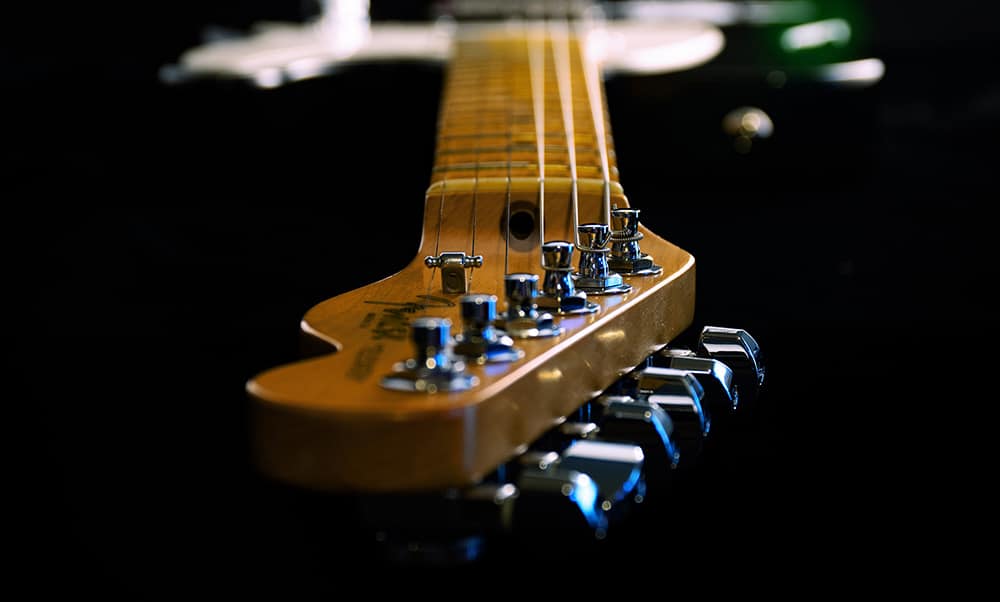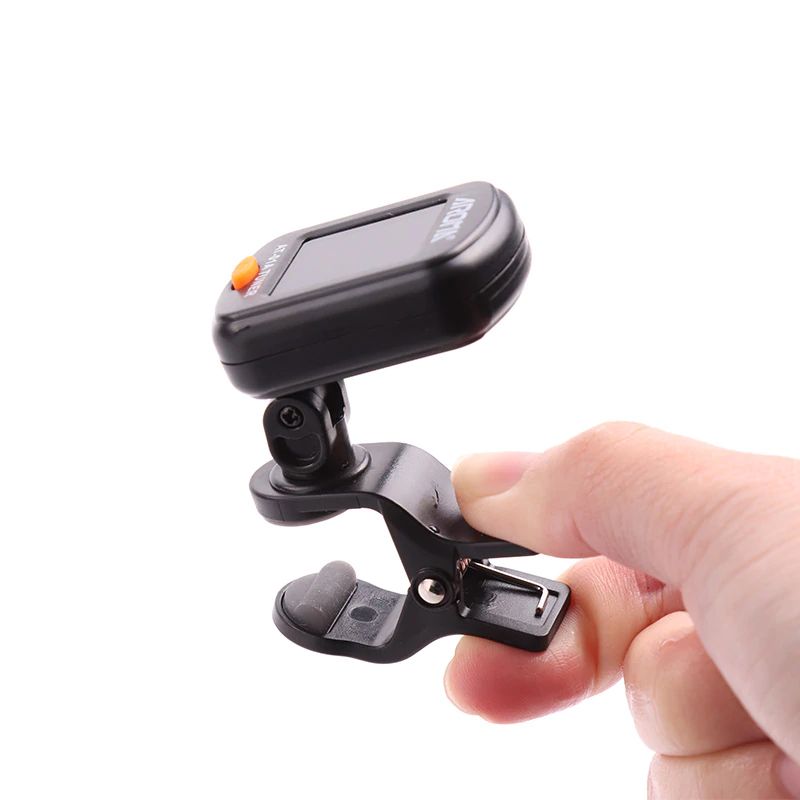Everyone starts somewhere right? The best way to get started playing your new guitar is knowing how to tune it properly! There are different ways to go about doing this and in this guide, we’ll show you the basics about how to tune a guitar.
How To Tune A Guitar: Getting Started…
Tuning machines are found on the headstock of your guitar. They have tiny gears inside that either make your strings more loose (de-tune pitch) or they make the string tighter (tune up the pitch).
There are thousands of different styles when it comes to tuning machines. But when it comes to tuning your guitar, they all work the same way!

If this is your first time tuning your guitar, get familiar with the tuning machines. Strum a single string without fretting a note and use the tuning machine for that string to change the pitch.
It’s easy to see how your tuning machines work. Don’t worry, you won’t hurt anything by trying them out and changing the pitch. Once you’re familiar with how your tuning machines work, it’s time to move on to the important part.
Tuning Your Guitar: Knowing The Notes & Why It Matters
There are a few things you are going to need to get started tuning your guitar. You need to know the notes to tune the strings to, of course. You will also need a good electronic tuner.
The notes are something you will eventually commit to memory. Whenever you are talking about tuning, you always start with the 1st string. The 1st string is always the skinniest/smallest string. Not the one that is closest to you when holding the guitar.
Standard tuning is the most widely used and popular. If you are learning from a teacher, they will almost always teach you how to play using standard tuning. It is the universal language of the guitar!
Standard Tuning is:
- 1st string: E
- 2nd String: B
- 3rd String: G
- 4th String: D
- 5th String: A
- 6th String: E

Of course, there are many other ways of tuning your guitar, called “Alternate Tuning”. But as a beginner, it is very important to stay focused on the Standard tuning.
Where Does Standard Tuning Come From?
If you are familiar with the Violin or the Cello, you know that those instruments are tuned to Fifths. In fact, most stringed instruments have followed this example for almost 1000 years!
But the guitar is special. In fact, it is something of an anomaly when it comes to the music world. The fret board has more real estate than say, a violin. This results in a wider range of notes that needs a different style of tuning.
The Guitar is tuned in a series of ascending (rising tone) perfect fourths and a single major third. To be specific, from low to high, standard guitar tuning is EADGBE as we discussed earlier.
Three intervals of a fourth (low E to A, A to D and D to G), are then followed by a major third (G to B), followed by one more fourth (B to the high E). So why doesn’t every stringed instrument follow that same formula?
- The guitar focuses on chord shapes, and standard tuning makes chords easier to achieve.
- It makes playing leads, and learning scale patterns easy
- The guitar has six strings and covers much more sonic territory than other stringed instruments.
- Standard Tuning on a guitar allows you to play with any other instrument easily.
- Most importantly, it minimizes the movements of your fretting hand.
So how do we get to these notes/pitches? Most people use an electronic tuner. Even the pros! Get into the habit of checking your tuning every single time you pick up your guitar to play.
Electronic tuners come in so many different forms these days. It can be overwhelming! So lets look at the two most popular kinds:
How To Tune A Guitar: Headstock Mounted Tuner
These are the best choice in my opinion and they can be found at any music store. They are also very budget friendly. But How do you use one?

These come in a ton of different shapes and sizes. But they all function the same way, essentially. These tuners pick up the vibration of your strings, to read what note is being picked up. Simply:
- Use the clip to attach the tuner to the headstock of your guitar.
- Check to make sure the clip is in full contact with the wood.
- Pluck the string you wish to tune.
- The electronic tuner will tell you the note.
- Your string may be sharp or flat. Simply use the tuning pegs to tighten or loosen the string, until it reaches desired pitch.
- Pluck the open string again, to make sure it is in tune.
Now you’re all done! You guitar doesn’t have to be plugged up to anything, and the tuning process is very quiet. These clip-on tuners are very accurate also.
Some people prefer something with more options, and more accuracy. That’s where our second type of tuners come into play.
How To Tune A Guitar: Floor and Stand-Alone Tuners
These electronic tuners are used in a totally different way. They are primarily used with electric guitars only. You have to plug your guitar up to the unit.

These tuners work the same as the headstock tuners. But you have to have the guitar plugged in with a cable. The advantage is the accuracy. The stand-alone tuners are the most accurate way to tune your guitar.
These are usually battery powered or they have an AC adapter that you plug into the wall. They are mostly used by people that repair guitars for a living, since they are so accurate.
You use the same steps mentioned above to use these stand-alone tuners. You just don’t have to clip it to your headstock. You follow all of the same steps.
How To Tune A Guitar: Other Methods/ Online Methods
These days you do not even need a piece of hardware to tune your guitar! You can do it on-the-fly with a phone app. These apps are usually free and easy to find.
Your amplifier may have a built in tuner as well. be sure to check your user manual to see if it does, and learn how to operate it.
There are YouTube videos that can be used to tune your guitar also. These channels play the open note several times and let it ring out, and you tune your guitar to match the pitch.
These are all perfectly good methods for tuning. But it is highly recommended to have your own tuner. Clip-on tuners are so inexpensive, some people have several.
Tips and Tricks
- Always check your tuning twice. Especially with new strings.
- Don’t get frustrated if it takes time to get it right. Every great player has to learn how to tune a guitar at some point.
- Check your tuning every time you play. Subtle shifts in the guitar could throw your tuning off.
- Experiment with your tuning machines. Some are tighter than others!
- The 1st string is always the skinny, E string.
- Find the tuning method that is easiest for you and fits your budget.
Keeping Your Guitar In Tune
There is a common myth that many guitarists believe about tuning machines and how relevant they are to keeping your guitar in tune. Tuning machines are definitely a part of it. But a guitar is a system of parts.
There are actually many factors that play into how long your guitar stays in tune. Sometimes you may need to have work done on your guitar. But sometime the problem may be something a novice can spot as well.
As a beginner, you want to focus on the easy factors that you can control. Sometimes there is a technical issue, or one of your guitar parts needs to be repaired. This will need the work of a professional technician.
There are some simple steps to take to make sure you are doing all you can when it comes to keeping your guitar in tune. Even when you are first starting to play:
- Make sure your strings are new or in good condition: Old strings will not hold tune properly. Many factors affect string life. If you are learning and practicing every day, then they should be replaced often.
- Stretch your new strings properly: It takes time for brand new strings to stretch and settle. Take the time to stretch them when they are new.
- Climate/ Environment: It is ideal to keep your guitar in a climate controlled environment with low humidity. The wood your guitar is made of is very strong, but still subject to climate shifts. The wood shifting may affect your tuning.
- Check the nut: 9 times out of 10, a tuning issue happens at the nut. If it is improperly cut or seated incorrectly in the neck, it can wreak havoc on your tuning. What is a nut? *insert anatomy link here*
In Conclusion…
Tuning a guitar properly is often the first step to becoming a great player. The same goes for keeping it in tune and being able to diagnose common issues. The best offense is often the best defense, right?
Having a guitar that is in tune will make your experience starting out much easier. It can be frustrating if you play the correct notes, but they sound bad or “off” for a beginner guitarist.
The last thing you want on your way to becoming a great guitarist is a roadblock like bad tuning practices. Especially since it so easily avoidable these days. The less roadblocks on your journey, the better.
Tuning a guitar is simple. And with all of the technology we have today it is easier than ever to learn! No matter which method you chose!

Leave a Reply